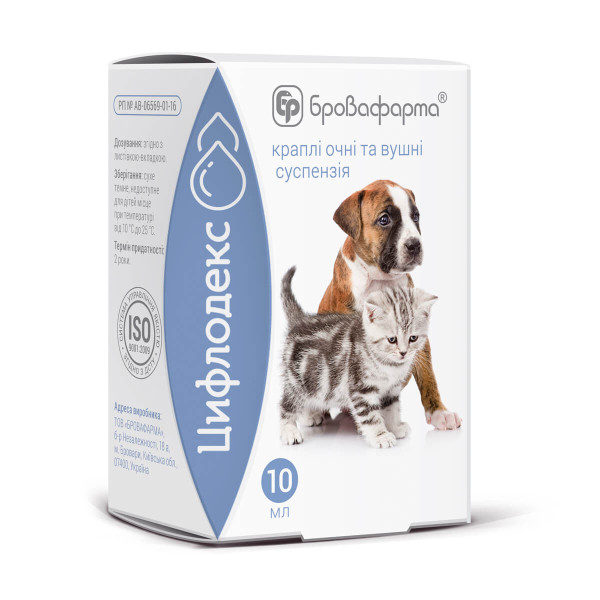Ciplodex Eye and ear drops 10ml
Ciplodex – White Suspension
Composition:
1 ml of the product contains: Ciprofloxacin hydrochloride – 4.5 mg, Dexamethasone sodium phosphate – 1 mg.
Pharmacological properties:
A combined chemotherapeutic agent that unites a broad-spectrum antibiotic from the fluoroquinolone group (ciprofloxacin) and a glucocorticoid (dexamethasone), providing antibacterial, anti-inflammatory, antiallergic, and desensitizing effects.
Ciprofloxacin acts bactericidally by inhibiting DNA gyrase and suppressing bacterial DNA synthesis. Active against gram-negative microorganisms in resting and dividing phases (Escherichia coli, Salmonella spp., Shigella spp., Proteus spp., Citrobacter spp., Klebsiella spp., Enterobacter spp., Vibrio spp., Campylobacter spp., Hafnia spp., Providencia stuartii, Haemophilus spp., Pasteurella multocida, Pseudomonas spp., Gardnerella spp., Neisseria spp., Moraxella catarrhalis, Acinetobacter spp., Brucella spp.) and against gram-positive microorganisms in dividing phases (Staphylococcus spp., Streptococcus pyogenes, Streptococcus agalactiae, Corynebacterium diphtheriae, Listeria monocytogenes), as well as other pathogens (Chlamydia spp., Mycoplasma spp., Mycobacterium spp.).
It is well absorbed: after 60 minutes, its concentration in tear fluid reaches 4.98 μg/ml, and in aqueous humor – 2.59 μg/ml. The half-life in the anterior chamber is 2 hours. After instillation into the eyes, ciprofloxacin concentration in blood does not exceed 2.5 ng/ml; after instillation into ears, maximum blood concentration is reached within 15–90 minutes and is about 0.1% of the concentration achieved with an oral dose of 250 mg.
Dexamethasone is a synthetic fluorinated glucocorticoid with anti-inflammatory, antiallergic, and antiproliferative effects. It reduces capillary permeability and proliferation, local exudation, cellular infiltration, phagocytic activity, collagen deposition, and fibroblast activity; suppresses scar tissue formation and inflammation symptoms. The anti-inflammatory effect after instillation lasts 4–8 hours. With local use, systemic absorption is low. After instillation into the eyes, dexamethasone penetrates well into the corneal epithelium, conjunctival cells, and aqueous humor; its maximum concentration (30 ng/ml) is reached after 2 hours, half-life – 3 hours. When instilled into the ears, maximum blood concentration is reached within 15–90 minutes and amounts to about 14% of that achieved with a 5 mg oral dose.
Indications:
For dogs, cats, small, exotic, and decorative animals to treat acute and chronic inflammations of the eyes and ears caused by bacterial, chemical, or traumatic factors: conjunctivitis, blepharitis, keratitis, keratoconjunctivitis, iriditis, iridocyclitis, corneal ulcers and erosions, eye injuries from trauma or foreign bodies, exposure to aggressive substances, in postoperative and preoperative periods; as well as otitis and otorrhea, including cases caused by foreign bodies.
Contraindications:
Do not use in animals with hypersensitivity to the active substances.
Dosage and administration:
Instill 1–2 drops into the conjunctival sac 2–4 times daily (in severe cases, during 1–2 days instill 1–2 drops every 2–3 hours) or into the ear canal 1–4 drops (depending on the animal’s body weight) 2–3 times daily.
If there are abundant purulent or mucopurulent discharges, perform preliminary hygienic treatment: instill 3–4 drops, remove discharges with a sterile gauze swab, then instill 1–2 drops of the product. Treatment continues until complete recovery, usually 5–10 days.
Warnings:
After eye instillation, local irritation, itching, or tearing may occur, which quickly subside; rarely – allergic reactions. With prolonged use, secondary glaucoma or steroid cataract may develop. Use with caution in animals up to 7 days old.
Packaging:
Polymer dropper bottle, 10 ml, in an individual carton box.
Storage conditions:
Store in a dry, dark place, out of reach of children, at +10°C to +25°C.
After opening the bottle, use within 30 days.
Shelf life: 2 years.

